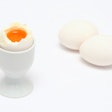Current technology is getting closer to developing egg alternatives that may compete with eggs, Dr. Thomas Herald, Kansas State University, said at the recent International Egg Commission annual conference in Guadalajara, Mexico. He added, however, that research needs to be conducted to determine what issues, if any, egg alternatives may face in full-scale processing.
Herald’s conclusions are based on the findings of a study at the university on egg substitutes in selected food systems. While eggs have the advantages of being highly rated as a food ingredient, there are concerns that eggs might be the single most expensive ingredient in some instances. “If food processors are satisfied with the performance of an alternative which was cheaper, then they will use it,” Herald said.
The goal of the research is to obtain a broad range of commercially advertised egg alternatives and compare their performance—physical and sensory properties to eggs in the selected food items, such as in mayonnaise, yellow cake, angel food cake, egg noodles, and French vanilla ice cream.
The control for mayonnaise was pasteurized liquid egg yolk while the competitors tested were wheat protein isolate, whey protein concentrates, modified corn starch and wheat protein concentrate plus fenugreek gum. The conclusion was that some of the egg alternatives evaluated were able to form oil/water emulsions that had similar physical, chemical and sensory properties as traditional mayonnaise made with egg yolk.
In cakes, 10 alternatives to dry whole egg were considered. However, no ingredient(s) exactly emulated all the properties of egg in yellow cakes and ingredients used in combination performed better than those tested individually. With regard to the angel food cake, whey protein isolate did not perform as well as the control in the physical attributes evaluation and the control (dried whole egg) significantly out-performed the angel food cake formulated with whey protein in all sensory categories. Furthermore, consumers indicated that they were willing to purchase the control two to one over the cake formulated with whey protein isolate.
Five alternatives to whole egg were considered for refrigerated pasta. Whole eggs exhibited a significantly lower cooking loss and were much firmer compared to the alternatives. Furthermore, whole eggs could not be totally replaced with any of the egg alternatives studied without loss of quality. In the ice cream study, the alternatives considered to whole eggs were 60% whey protein concentrates, modified corn starch, and soy protein. None of the alternatives consistently emulated or even equalled the overall performance of eggs. However, there was at least one egg alternative that was extremely competitive in a specific physical or sensory property.
More products feature eggs
From the 12 months ending August 2006, the number of food and beverage products utilizing eggs worldwide jumped by a massive 38% to 1,275 from 927 a year earlier, Steve Pintarelli, of Stagnito’s New Products Magazine, USA, told attendees to the Egg Processors International Session.
In terms of stock keeping units the number actually went up by 40% from 1,845 to 2,577.
Describing trends in U.S. eating habits, he said that many new products were designed to make life easier as consumers wanted eating to be faster and more fun. This has led to the development of grab-and-go items, in a cup, on a stick, in a tube or in a bag. There is a trend towards convenient/healthy meals presented in resealable packaging, often provided in individual portions offering more variety. “Meal replacement bars and fortified food beverages are in high demand,” he added.
A University of Illinois study shows that comfort foods are popular, with women preferring snack-related items and men meal-related comfort foods.
He said some 66% of consumers claim to use organic products at least occasionally and the market value was predicted to reach $30.7 billion by 2007.
- European Union
Speakers gave a round-up of processing issues around the world. Ton van Dijk of the European Union said that although there had been some changes, little has changed in the EU egg market overall. The EU’s population currently standing at 467 million, represents a huge consumer market.
Egg production has grown from 102 billion eggs in 2003 to 106 billion in 2005. The proportion of non-cage eggs is growing annually and represents about 22% of total output compared with 17% in 2003.
Annual egg consumption averages around 240/person.
The region’s self-sufficiency rate had risen from 101% to 103%, so some 3% of eggs have to find a “home” outside the EU. Production of egg products has also expanded from 1.39 million tons in 2003, when it represented 22% of output, to 1.6mt last year and accounts for 25% of all table eggs.
Between 2000 and 2005 the EU enlargement from 15 to 25 countries boosted the population by some 20%. During this period, five processors disappeared as a result of mergers/takeovers or bankruptcy and there are now three major companies accounting for between 40-45% of the market. Nevertheless, there is still a large number of medium to small operations and some new companies had entered the market. But there was no dominant company, van Kijk said.
The period had seen considerable technical improvements as a result of better and more efficient machinery. However, this had led to cheaper products rather than better profits, he said. Product specifications had become more stringent over the period.
The big change was that there were fewer but larger food processors and retailers and they continued to be the dominant players in the market. It is therefore still largely a buyers market with commodity-type products that were cost/price driven.
“Consequently, on a long-term basis, the egg processing market doesn’t generate real shareholder value,” he observed. “As a result, all the major egg processing companies in the EU are family-owned private companies with less capital resources when compared to publicly-owned companies with access to the stock exchange.”
van Kijk said the market needed a leading supplier that could match the dominant buyers to bring back some equality to the market. “This had happened in the dairy market and more recently in the red meat market, so why not in the egg market?” he asked.
- United States
“The U.S. egg product industry is currently in a state of over production, reflecting the situation on the shell side. But, despite this, new capacity is still being added,” said Al Pope, president of the United Egg Producers.
Egg processors are putting in their own production facilities, he said. Shell egg producers have traditionally looked to the egg processors as their best customer for taking their surpluses. The industry was now in a transition period. These changes, which increased production and consolidation in the industry, will continue to put pressure on egg prices and profitability in the near future. However a number of companies that are selling added-value products have protected their ability to maintain profits.
Currently egg processors use one-third of U.S. shell egg production. According to the USDA, over 41% of the 68 million cases of eggs broken in 2005 were processed on in-line breaking facilities, while more recently, the department has reported that more than 50% of the eggs going to processors were handled in this way. And most of these eggs were sold on a cost plus basis, which enabled the processors to offer their customers a consistent or longer-term price.
“This solves a huge problem for them as the shell market prices fluctuate so much, which makes it more difficult when trying to deal with customers on a long-term basis,” he added. “This is a good decision for them as, with an in-line facility, the bacteria count is so low that they get very high quality eggs going into the plant which makes it easier to pasteurize, and there is no transportation cost,” Pope continued.
Output of egg products rose by 6.2% in 2005 to 1.33 million tons. Exports of egg products climbed to almost 39,000 tons from just under 35,200 tons in 2004, while the estimate for 2006 was 41,000 tons. Japan, Canada, Mexico and Korea are the leading buyers of U.S. egg products.
- Asia
Although question marks can be put against much of the data that emerges from Asia, there is no question that this is by far the largest egg producing region of the world, accounting for 39 of the 59 million tons, said Morten Ernst. China is the biggest player with an annual output of between 25 and 27 metric tons.
Avian influenza continues to be the dominant scare word throughout the region, he said. “As only a couple of countries have escaped the virus, most egg users in the local food industries are showing an increased interest in importing safe egg products, while some local egg producers are flirting with the idea of building their own egg plants to cash in on the scare,” he added.
Malaysia is a good example of this with four new liquid plants being built in the past few years aimed at supplying local food processors with a safe alternative. However, one had closed and the remaining three were fighting for the same few customers with the result that plant utilization was somewhere between 20-25%.
In China, there is great interest in setting up new plants, Ernst said, but their potential customers—Chinese food processors—are completely price oriented and not prepared to pay for the added safety, convenience and hygiene which the new plants could offer. “In fact, some processors are mixing cheaper ingredients into their egg products in order to cut prices. With low margins domestically, they are looking to exports but many countries have banned Chinese poultry products, including eggs and egg products. The end result is that plant utilization may be as low as 40%,” he said.
In South Asia, it has been 10 years since the first egg products plant went into production in India. Soon after, several others were established. But they were all dependant on exporting their powders, with egg consumption in India so low. Several factories failed and today there are fewer than a handful of good plants in business.
The industry in Korea had expanded dramatically in the past few years and currently there were 13 factories with a combined daily breaking capacity of close on 400 tons of liquid eggs. “But, last year the actual output was less than 150 tons/day,” Ernst added.
Taiwan has seen a surge in new factories, mainly resulting from the government implementing regulations and given financial support to plants with pasteurization. “However, the government did not realize that the Taiwanese food industry prefers the yolks intact-often packed in a clear bottle. To produce whole egg yolks after pasteurization is not possible. So, the pasteurization process is often bypassed,” Ernst observed.
Thailand has only a couple of plants catering to the local industry, so the volume of imported egg products was larger than any other Asian country, except Japan.
There is no processing industry in Indonesia, Vietnam, the Philippines, and Pakistan.
Japan has some 70 factories, producing about 500,000 tons of liquid eggs a year.
Interest in egg products is definitely growing in Asia and the bird flu issue was generally considered to be a problem that would not go away, hence governments are encouraging heat-treated egg products. “However, these governments must also look to protect their egg producers. Although egg product imports are small, they pose a threat,” he added.
Despite the World Trade Organisation’s lowering of import duties for greater access to markets, other protective barriers are appearing, such as, complicated import procedures and restrictions, quality requirements, and religious and certification demands that are a challenge to exporters. Most imported products into the region are in powder form generally going to internationally oriented and educated food processors. The mentality behind egg products being a popular ingredient in the developed world was not a factor in Asia—yet. He said that labor has been cheap, hygiene often of little concern, and convenience did not matter—price did.
Out of the 20kg of eggs the average Japanese eat each year, 10kg would be in product forms. “So there is hope that markets like Korea, Taiwan, Singapore and Hong Kong will follow suit in the future,” he added. “Education, food poisoning, bird flu, Severe Acute Respiratory Syndrome (SARS), regulations, food safety awareness and increased disposable incomes are just some of the factors that will increase the use of egg products in Asia,” Ernst concluded.
- Mexico
Mexico is the largest consumer of eggs/person in the world, with the annual figure exceeding 340. The proportion of total output going to processors is about 10% and growing, said Cesar de Anda. The demand for egg products is increasing, although he admitted that the industry is still in its infancy compared with the leading egg products’ producing countries.
The egg processing industry only really started to develop in the mid-1990s, he said, and now is focussing on producing value-added products. Even though it is difficult to find such items in liquid form in the supermarkets today, he forecasts that added-value products will start to appear on the shelves in the next couple of years.
“Exports are increasing annually, especially to Japan and European countries. We now have free-trade agreements with more than 30 countries worldwide,” he said. The current emphasis is on producing high quality products to ensure that Mexico becomes a major player in the export business. Like their European counterparts, he said there was need to increase the value of Mexican processing companies.EI

















